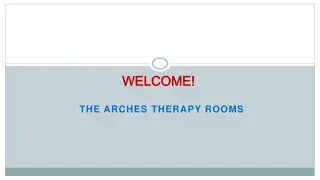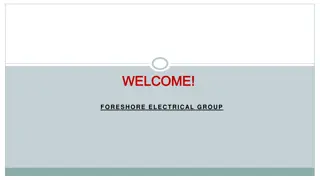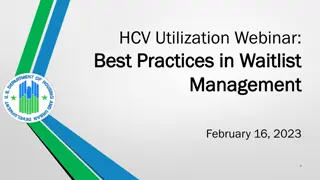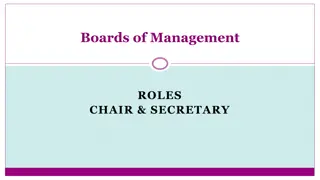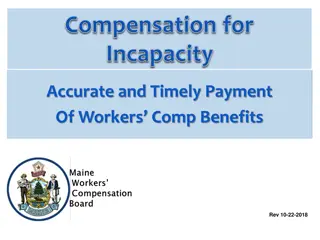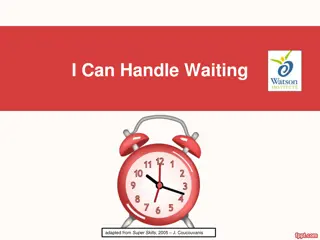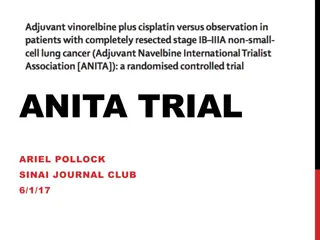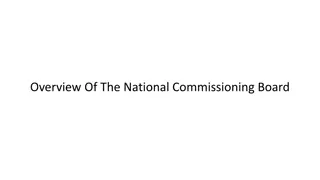Enhancing Waiting List Management Through Visual Management Boards in Integrated Therapies
Implementing visual management boards and daily huddles in Integrated Therapy Teams improved waiting list management by standardizing triage processes, validating waiting lists, addressing breaches, and maximizing new patient capacity. Stakeholder engagement and identification of root causes such as staff development, passive culture, and lack of ownership were crucial in the transformation process towards efficient waiting list control.
Download Presentation

Please find below an Image/Link to download the presentation.
The content on the website is provided AS IS for your information and personal use only. It may not be sold, licensed, or shared on other websites without obtaining consent from the author.If you encounter any issues during the download, it is possible that the publisher has removed the file from their server.
You are allowed to download the files provided on this website for personal or commercial use, subject to the condition that they are used lawfully. All files are the property of their respective owners.
The content on the website is provided AS IS for your information and personal use only. It may not be sold, licensed, or shared on other websites without obtaining consent from the author.
E N D
Presentation Transcript
The Impact of Visual Management Boards on Waiting List Management In Integrated Therapies Rebecca Emmott @remmottphysio @ELHT_AHPs
UNDERSTAND Aim To introduce visual management boards as standard practice across the Integrated Therapy Teams in order to allow understanding and control of the flow of referrals in 6/12. Waiting List Management Control (WLMC) was put in place to support the standardisation of triage moving from SPOA into localities. Implementation of Visual Management Control Boards and daily huddles to support WLMC on a daily, weekly & monthly basis. Ensures validation of waiting lists, breaches and difficult to book appointments are actioned on a daily basis. Promotes team forecasting and planning into the future to maximise new patient capacity.
UNDERSTAND Current state Visual Management Boards were introduced as an effective tool to support waiting list management control and address the following: Poor patient access and escalating waiting times breaching on KPIs Mismatch of staff capacity to demand Team July 2020 Total: 149 Urgent: 21 Routine: 128 BITT Total wait list for ITT July 2020 Total: 428 Total: 104 Urgent: 18 Routine: 86 PITT Total: 65 Urgent: 4 Routine: 61 HITT Urgent: 58 Total: 93 Urgent: 12 Routine: 81 RITT Routine: 370 Total: 17 Urgent: 3 Routine: 14 RVITT
ROOT CAUSE People Process Staff development and education Staff unable to book own patients Passive culture Lack of accountability for waiting lists Don t know what is on the waiting list Inflexible diaries No set induction No ownership of waiting lists Staff don t look at working list Clinicians don t use a diary feature Triage in SPOA not in teams Lack of understanding Lack of awareness of process SPOA unable to keep up with booking Lack of ownership Clinicians think its only a maximum of 5 patients to see No ownership of own time or diary demands Poor management of waiting lists in ITT Unclear leadership structure Reduced staffing Impact of out of hours/emerg ency visits Lack of Cross locality working Lack of vision and direction accountability for activity in diary Travelling long distances between sites High sickness Undefined structure No strategic Maternity leave oversight/management focus Sunday working emergency Leadership Staffing Cost
CO-DESIGN Driver Diagram Set diary templates Reduced capacity during extended hours & weekend work for emergency only Consultation for B4 s Varied skill mix across B4 Reduced staff autonomy for diary ownership Twice weekly Sit-tep Patients breaching on urgent & routine KPI s Localities working in-silo Implementation of VMB s and daily huddles in all locations No team discussion around waiting list Aim: Triage in SPOA with no team ownership To introduce visual management boards as standard practice across the Integrated Therapy Teams in order to allow understanding and control of flow of referrals from push to pull in 6/12. Inequity of waiting lists across ITT Locality staff booking Reduced staffing in localities Reduced time for supervision & IST Permissions to diaries for staff No clinician ownership of diaries & waiting lists Control of diaries/appointments by SPOA Zonal working & cross locality working Longer working hours 8-8 Low staff satisfaction due to no zonal working Implementation of care home days & assigning care homes Ownership of area/caseloads Staff unable to book NP s off waiting list Review of weekend working & extended hours Inefficiency of zonal working Covering all ITT localities
CO-DESIGN Future state Every team to have standardised WLMC boards Staff/ team ownership of EMIS diaries and waiting list Gives assurance in information provision from every member of the team Promotes team leadership at every level Improved understanding of pressures at team level Cultural shift, raising staff morale, staff feeling empowered - creating positive can do attitude moving towards self managing teams Cross working across boundaries to support KPI s
TEST & ADAPT What we did Implemented standardised WLMC visual management boards into each team Implemented daily huddles Implemented digital WLMC boards for monthly team returns Cross working across boundaries to support KPI s Huddle sheet standardisation Continued to link closely with SPOA
TEST AND ADAPT PDSA Record or Action Sheet Cycle Record (Each Row = One Experiment) Plan Do Study Act What did we learn? How will you overcome this in the next cycle? Date/Step/By When What do we expect? What actually happened? Increased knowledge of patients on waiting list by all staff Implemented standardised WLMC visual management boards into each team Prediction and management of waiting list breaches. Implemented daily huddles Ability to effectively risk manage patients on the waiting list Reduction in waiting times for patients By having VMB and daily huddles there was a reduction in breaches against the KPI s for patients Implemented digital WLMC boards for monthly team returns Lean decision making in huddles re: travel / care homes / cover of sickness NP & F/U Reduction in waiting lists across ITT Cross working across boundaries to support KPI s Increased activity in all teams Increased awareness across all levels of the waiting list Increase in capacity and NP slots offered and actively working to minimise lost slots More capacity to meet the demand Reduction in mileage Huddle sheet standardisation Significant impact on patient access and waiting times More staff ownership of diaries and waiting lists Increased staff ownership of diaries and waiting list Achieving sustainable waiting lists Continued to link closely with SPOA Achieving KPI for triage & triage queries A more responsive service
TEST & ADAPT Impact Increased knowledge of patients on waiting list by all staff Prediction and management of waiting list breaches. Ability to effectively risk manage patients on the waiting list Lean decision making in huddles re: travel / care homes / cover of sickness NP & F/U Increase in capacity and NP slots offered and actively working to minimise lost slots Significant impact on patient access and waiting times Achieving sustainable waiting lists Achieving KPI for triage & triage queries A more responsive service
TEST & ADAPT Impact
TEST & ADAPT Impact
TEST & ADAPT Impact Team July 2020 December 2021 October 2022 Total: 149 Urgent: 21 Routine: 128 Total: 27 Urgent: 1 Routine: 26 Total: 9 Urgent: 2 Routine: 7 BITT Total wait list for ITT 20/5/2022 Total: 168 Total: 104 Urgent: 18 Routine: 86 Total: 89 Urgent: 19 Routine: 70 Total: 33 Urgent: 5 Routine: 28 PITT Total: 65 Urgent: 4 Routine: 61 Total: 33 Urgent: 2 Routine: 31 Total: 29 Urgent: 3 Routine: 26 HITT Urgent: 20 Total: 93 Urgent: 12 Routine: 81 Total: 20 Urgent: 2 Routine: 18 Total: 20 Urgent: 3 Routine: 17 RITT Routine: 148 Total: 17 Urgent: 3 Routine: 14 Total: 17 Urgent: 3 Routine: 22 Total: 12 Urgent: 2 Routine: 10 RVITT
TEST & ADAPT Impact
EMBED SPREAD SUSTAIN Key Learning Importance of consideration of key stakeholders Importance of self-managing teams Effective diary management in line with NHS job planning and allowing staff autonomy around management of diaries Oversight from CTL s looking at capacity following daily huddles
EMBED SPREAD SUSTAIN Next Steps SPOA to increase links with all ITT s Utilising KATA to support with spread to SPOA Teams to continue to look at new ways of working around zonal working Feed into District Nurses Safety Huddles to enable decisions around integrated approach to the management of patients on both caseloads
EMBED SPREAD SUSTAIN Any Questions?






